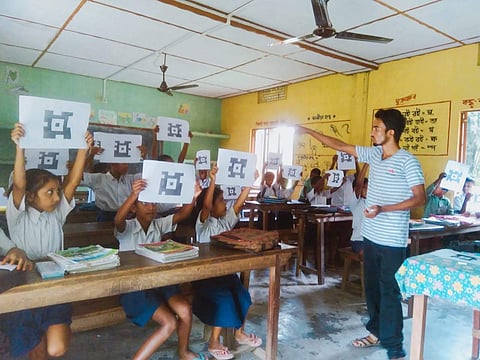

Quantifying how much of what is taught in class a student can grasp has been a problem that the education sector has been dealing with for decades. Abhinav Tripathi, Nilesh Suthar and Anuj Kosambi — all batchmates from the Dhirubhai Ambani Institute of Information and Communication Technology (DA-IICT) in Gandhinagar, Gujarat — claim to have solved this problem and that too quite elegantly, we must say. Their brainchild, piCards - a formative assessment system that encourages student participation while evaluating responses and tracking performances, can now help teachers know if they are getting through to the kids in their class. Based out of Bengaluru, their EdTech start-up, 22bate7, operates across 22 states and has impacted 2.5 lakh kids in the past year and a half.
So, what do they feel is the best way to understand how much students have retained? Tests, of course. "The teachers give the students multiple-choice questions and they just hold up the piCards, which look like QR codes. Every 90° turn gives a different code that has already been attributed to an option. So, the kids hold up the cards in a way that the option they choose is on top. The teacher can simply point their phone's camera and the app scans all the cards at once. It hardly takes 20 seconds," explains Abhinav who co-founded 22bate7 in February of 2017. He ideated the concept while on his internship with Microsoft. Inspired by his work there, he started developing a separate algorithm that is now the technology behind the piCcards. "It not only helps the teachers know how much the students have learnt but gives them the extent of the entire learning. If the correct answer is B and a lot of the students have answered C, then the teacher can retrace their steps and get back to what possibly went wrong," he adds.
At present, a chain of schools with their headquarters in Karnataka uses their tech at 30 of its centres across India. Not just that, NGOs use their technology much more extensively to assess their project reach after each session, at schools.
More than 2.5 lakh students have been reached so far and Abhinav claims that even the government officials they had pitched their idea to were nothing but impressed. "We have spoken to the education department of Andhra Pradesh and Delhi, but since the procedure takes a lot of time and we have a very small team of just three people, we could not pursue it at that point. The NGOs help us reach out to more people at this point," says Abhinav. "piCards are faster and much more effective. Earlier, they had to collect data manually, go to the nearest internet café and upload the data and then, send a report. Now, it's done with just a few photos and we get the data instantly and our analytics processes it and gives them their required data as they want it much faster. It is not just time-saving but much more efficient. We train a handful of the NGO workers and a few of their collaborators and they train the others on the ground level," says Abhinav, adding that the more people they reach, the closer they get to their aim of serving society and also earning a decent revenue.
